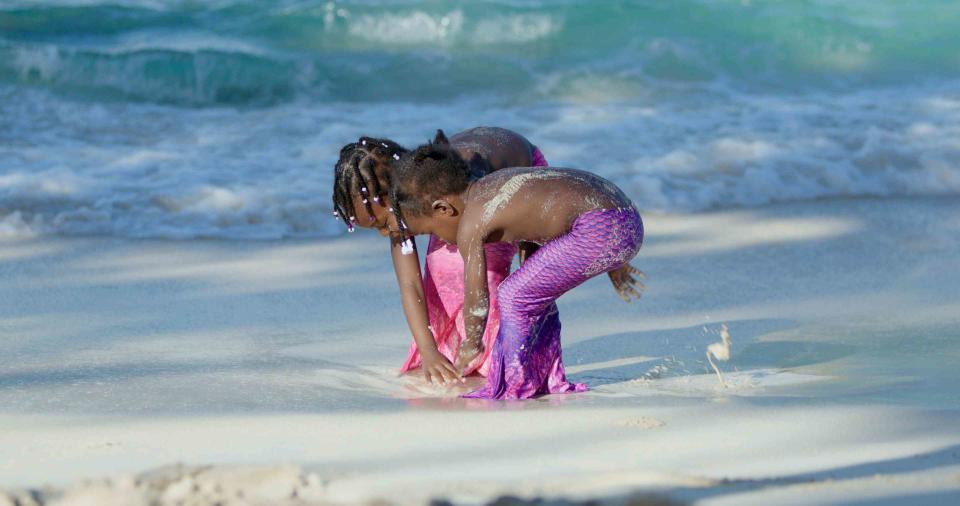10 Mythical Mermaids of Color That Came Before 'Little Mermaid'
- Oops!Something went wrong.Please try again later.
Author of 'Mermaid and Pirate,' Tracey Baptiste, says long before the upcoming Disney remake, cultures around the world told these fairytales.

E+/Getty
There are plenty of fish in the sea, and as it turns out, lots of mermaids too—all kinds of them, in warm and cold water, salt water, and fresh. In cultures from ancient to modern, stories of magical beings that live beneath the water’s surface abound. Most are fierce and formidable creatures, bent on self-determination—and many are people of color.
Hans Christian Andersen’s The Little Mermaid, written in 1837, popularized by Disney in the 1989 movie, and an upcoming remake featuring Halle Bailey, is only one story of a creature willing to give up anything for what she wants. There are many more. But beware Disney purposefully watered-down Andersen’s tale because mermaid stories—no matter their origin—are often gory and tragic.
The "Watermeid" of Karoo, South Africa
One of the oldest mermaid stories comes from Karoo, South Africa. Reddish brown cave paintings depict a group of mermaids diving and dancing. The mermaid of Karoo is believed to still live in the caverns there. Locals fear this “watermeid.” Responsible for the rain, she can cause flooding or drought, and if anyone gets close enough, she will drown them.
The Nommo, Mali
The Dogon of Mali tells a legend of the god of the universe, Amma, that sent the nommo to Earth. These half-human, half-fish creatures could only survive in the water. The nommo were genderless and the original ancestors of the Dogon people, responsible for all their knowledge.
Mami Wata, West Africa
The West African mermaid, Mami Wata, or “Mother of the Water” is a beautiful goddess. She appears as a woman with a fishtail, or as a woman with a large snake wrapped around her body. She can cause sickness or heal and is especially beloved as a goddess of fertility. She is worshipped among people from Benin, Ghana, and Togo.
Mama D'Leau, Trinidad
Mama D’Leau, from the Caribbean countries of Dominica and Trinidad and Tobago, is most closely related to Mami Wata. Her name also means “Mother of the Water.” She has the upper body of a beautiful woman and the lower body of an anaconda.
She is a protector of water creatures and is fond of drowning people and sinking boats. Any evil men sent to her by her husband, Papa Bois (Father of the Woods) are married and bound to her for two lifetimes. This makes her the only mermaid with multiple husbands.
La Siréne, Haiti
La Siréne from Haiti is a water spirit central to the vodou tradition with dark skin and a fishtail. She carries two objects: a mirror that serves as a portal between our world and a mystical one, and a gold trumpet that brings wealth to anyone that finds it. She has a beautiful singing voice, but will kill anyone who disrespects her.
Iara, Brazil
Brazil’s Iara was an indigenous woman of the Tupi people. Her father was a shaman, and her brothers were warriors. Because she was more skilled as a warrior than her brothers, the boys attempted to kill her in her sleep.
She overpowered and killed them instead. Then her father ordered her to be killed for the crime. After being dumped in the river, the fish remade Iara into a mermaid. She is believed to resurface to lure men into the water with her beautiful singing voice.
Menana, North America
Menana is another North American mermaid from an unspecified native nation. She was once a human who gave up her body to live among the stars but decided to return to her human life. The Great Spirit gave her a body with scales and two fishtails as legs.
As she grows up she becomes more human-looking. But when she is not allowed to marry the person she loves, Menana throws herself into the water and returns to the realm of the spirits. The spirits take revenge on the people, but Menana saves her love to live with her under the water.
The Ningyo, Japan
The Ningyo of Japan have the body of a fish and a human or monkey’s head. They cry pearl tears, can tell the future, and if a person eats their flesh they will have near-immortality. There is a legend of a fifteen-year-old girl who ate a ningyo and lived for 800 years.
The Mermaid of Tung-T'ing Lake, China
A Chinese legend tells of a scholar sailing on the Tung-T’ing Lake who saves a large fish from certain death. After he himself nearly drowns on that same lake, he manages to make his way to an island inhabited by a royal family. When he is discovered, he is sentenced to death but the queen stays the execution. She remembered that he had saved her when she was in her fish body.
The Naginis and Nagas, India
The naginis (female) and nagas (male) of India have human bodies with a serpentine lower half. They live in rivers and pools and can shapeshift to appear fully human. They are said to be exceptionally beautiful. The naginis are associated with fertility and protection.
These are only a few of the world’s existing mermaid stories. They are magical creatures that straddle the two realms of water and land and have captivated virtually every culture on the planet. There is something haunting and humbling about them, even the most dangerous ones.
Perhaps we are fascinated by these fairytales because they are about creatures that can do things that humans cannot, perhaps it’s because they often show grit in the face of adversity. Or it may be because they look so different from us. Whatever it is, the human fascination with mermaids will probably exist as long as water touches land.
For more Parents news, make sure to sign up for our newsletter!
Read the original article on Parents.

